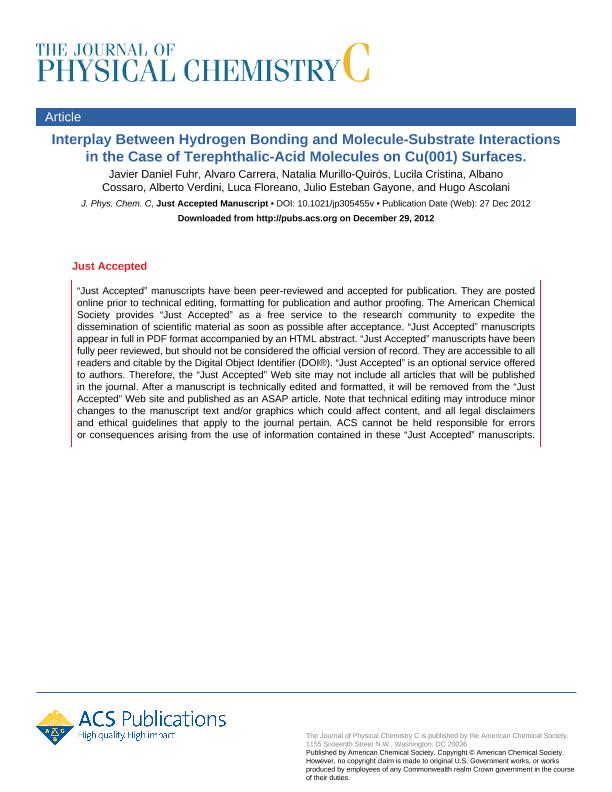Mostrar el registro sencillo del ítem
dc.contributor.author
Fuhr, Javier Daniel

dc.contributor.author
Carrera, Alvaro Daniel

dc.contributor.author
Murillo Quiros, Natalia Maria

dc.contributor.author
Cristina, Lucila Josefina

dc.contributor.author
Cossaro, Albano
dc.contributor.author
Verdini, Alberto
dc.contributor.author
Floreano, Luca
dc.contributor.author
Gayone, Julio Esteban

dc.contributor.author
Ascolani, Hugo del Lujan

dc.date.available
2017-01-17T13:39:49Z
dc.date.issued
2012-12
dc.identifier.citation
Fuhr, Javier Daniel; Carrera, Alvaro Daniel; Murillo Quiros, Natalia Maria; Cristina, Lucila Josefina; Cossaro, Albano; et al.; Interplay between Hydrogen Bonding and Molecule-Substrate Interactions in the Case of Terephthalic Acid Molecules on Cu(001) Surfaces; American Chemical Society; Journal of Physical Chemistry C; 117; 3; 12-2012; 1287-1296
dc.identifier.issn
1932-7447
dc.identifier.uri
http://hdl.handle.net/11336/11451
dc.description.abstract
The adsorption and self-assembling properties of terephthalic acid (TPA) molecules deposited on Cu(001) at room temperature have been systematically studied using both experimental and theoretical tools. The system forms two phases at room temperature, the metastable β-phase and the stable 3×3 one. In the case of the β phase, the low-energy electron diffraction and scanning-tunneling microscopy (STM) results indicate that the β phase has a (9 √ 2×2 √ 2)R45◦ unit cell with exactly the same molecular coverage as the 3×3 phase. In addition, the high-resolution X-ray photoelectron spectroscopy O1s spectra indicate that the irreversible β → 3 × 3 transition involves the following two processes: i) deprotonation of the complete carboxyl groups remaining in the metastable phase and ii) re-arrangement of the molecules into the 3×3 configuration. On the other hand, we explored possible molecular configurations for the β phase with different degree of deprotonation (including structures with Cu adatoms) by means of density functional theory calculations. Our theoretical results indicate the formation of strong bonds between the O atoms in carboxylates and the Cu atoms of the surface, which causes a bending of the molecules and a buckling of the first Cu layer. In the 3 × 3 phases, we show that the bending produces observable effects in the molecular STM images. We also observed that the strong interaction between the carboxylates and the Cu atoms at the step edges drives the reorientation of the surface steps along the < 100 > crystallographic directions.
dc.format
application/pdf
dc.language.iso
eng
dc.publisher
American Chemical Society

dc.rights
info:eu-repo/semantics/openAccess
dc.rights.uri
https://creativecommons.org/licenses/by-nc-sa/2.5/ar/
dc.subject
Terephthalic Acid
dc.subject
Cu(001)
dc.subject
Self-Assembling
dc.subject
Dft
dc.subject
Scanning-Tunneling Microscopy
dc.subject
Xray Photoelectron Spectroscopy
dc.subject.classification
Física Atómica, Molecular y Química

dc.subject.classification
Ciencias Físicas

dc.subject.classification
CIENCIAS NATURALES Y EXACTAS

dc.title
Interplay between Hydrogen Bonding and Molecule-Substrate Interactions in the Case of Terephthalic Acid Molecules on Cu(001) Surfaces
dc.type
info:eu-repo/semantics/article
dc.type
info:ar-repo/semantics/artículo
dc.type
info:eu-repo/semantics/publishedVersion
dc.date.updated
2017-01-06T20:04:42Z
dc.journal.volume
117
dc.journal.number
3
dc.journal.pagination
1287-1296
dc.journal.pais
Estados Unidos

dc.journal.ciudad
Washington
dc.description.fil
Fil: Fuhr, Javier Daniel. Comisión Nacional de Energía Atómica. Gerencia del Area de Investigación y Aplicaciones No Nucleares. Gerencia de Física (Centro Atómico Bariloche); Argentina. Consejo Nacional de Investigaciones Científicas y Técnicas; Argentina
dc.description.fil
Fil: Carrera, Alvaro Daniel. Comisión Nacional de Energía Atómica. Gerencia del Area de Investigación y Aplicaciones No Nucleares. Gerencia de Física (Centro Atómico Bariloche); Argentina. Consejo Nacional de Investigaciones Científicas y Técnicas; Argentina
dc.description.fil
Fil: Murillo Quiros, Natalia Maria. Comisión Nacional de Energía Atómica. Gerencia del Area de Investigación y Aplicaciones No Nucleares. Gerencia de Física (Centro Atómico Bariloche); Argentina. Consejo Nacional de Investigaciones Científicas y Técnicas; Argentina
dc.description.fil
Fil: Cristina, Lucila Josefina. Comisión Nacional de Energía Atómica. Gerencia del Area de Investigación y Aplicaciones No Nucleares. Gerencia de Física (Centro Atómico Bariloche); Argentina. Consejo Nacional de Investigaciones Científicas y Técnicas; Argentina
dc.description.fil
Fil: Cossaro, Albano. Consiglio Nazionale delle Ricerche. Istituto Officina dei Materiali; Italia
dc.description.fil
Fil: Verdini, Alberto. Consiglio Nazionale delle Ricerche. Istituto Officina dei Materiali; Italia
dc.description.fil
Fil: Floreano, Luca. Consiglio Nazionale delle Ricerche. Istituto Officina dei Materiali; Italia
dc.description.fil
Fil: Gayone, Julio Esteban. Comisión Nacional de Energía Atómica. Gerencia del Area de Investigación y Aplicaciones No Nucleares. Gerencia de Física (Centro Atómico Bariloche); Argentina. Consejo Nacional de Investigaciones Científicas y Técnicas; Argentina
dc.description.fil
Fil: Ascolani, Hugo del Lujan. Comisión Nacional de Energía Atómica. Gerencia del Area de Investigación y Aplicaciones No Nucleares. Gerencia de Física (Centro Atómico Bariloche); Argentina. Consejo Nacional de Investigaciones Científicas y Técnicas; Argentina
dc.journal.title
Journal of Physical Chemistry C

dc.relation.alternativeid
info:eu-repo/semantics/altIdentifier/url/http://pubs.acs.org/doi/abs/10.1021/jp305455v
dc.relation.alternativeid
info:eu-repo/semantics/altIdentifier/doi/http://dx.doi.org/10.1021/jp305455v
Archivos asociados
